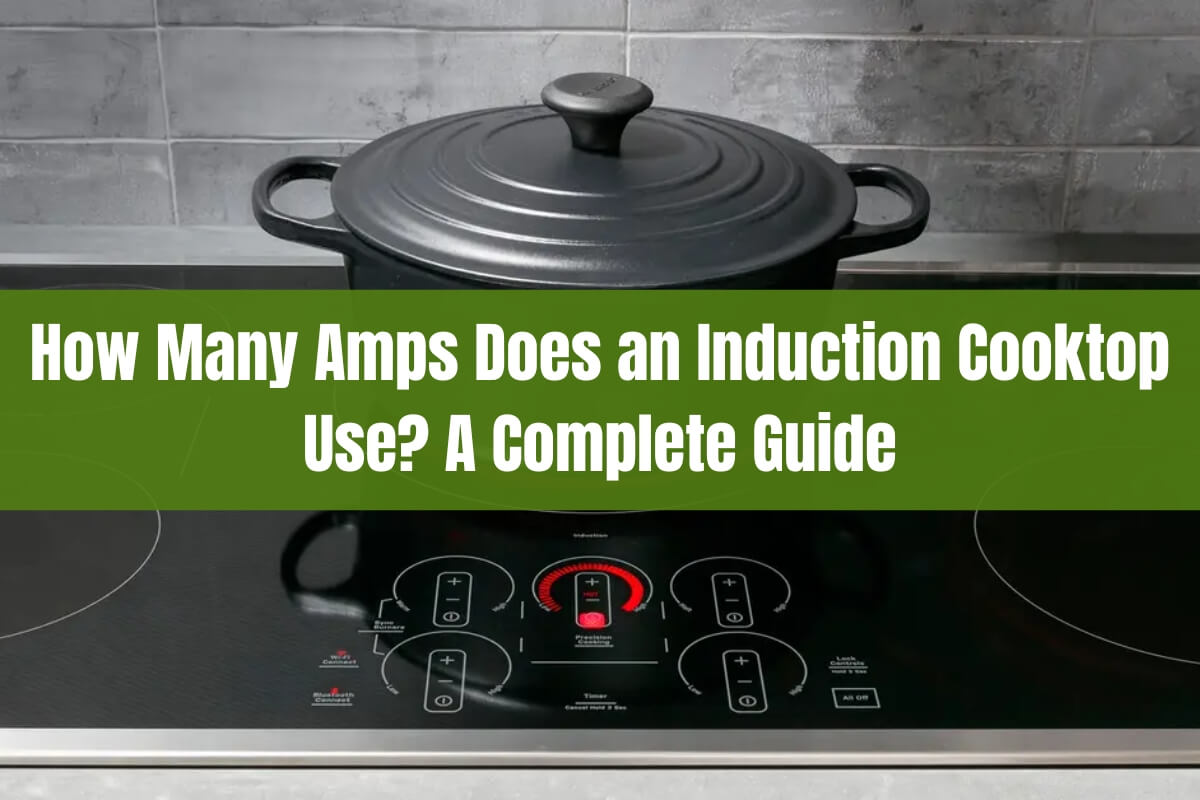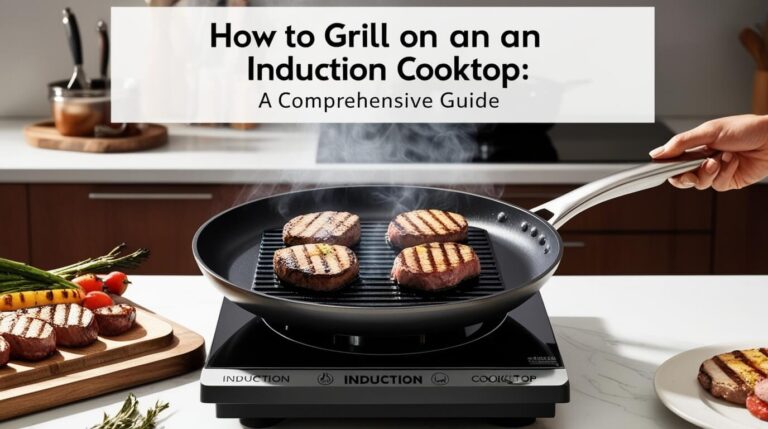
Have you been considering making the switch to an induction cooktop but are unsure about the electrical requirements? Induction cooktops have become increasingly popular in recent years, offering a sleek, modern design and unparalleled cooking performance. However, one crucial factor to consider is the amperage needed to power these advanced cooking surfaces.
How many amps does an induction cooktop use? Most induction cooktops require between 20 and 42 amps of electrical current, with a standard 30-inch model typically using 2,000 to 5,000 watts (approximately 20-42 amps).
Induction cooktops require more power than traditional cooking methods, raising questions about their electrical needs. This guide explains why they need more amperage, how to upgrade your electrical system, and how to select the right induction cooktop. You’ll also learn about the energy efficiency benefits and get practical tips for safe and optimal use.
What is an Induction Cooktop?
Before we delve into the amperage requirements, let’s briefly understand what an induction cooktop is and how it differs from traditional cooking methods.
An induction cooktop is a type of electric cooking surface that uses electromagnetic induction to directly heat cookware made of ferromagnetic materials, such as cast iron or magnetic stainless steel. Instead of relying on radiant heat or an open flame, induction cooktops create a magnetic field that induces electric currents within the cookware itself, causing it to heat up.
This innovative technology offers several advantages over gas or traditional electric cooktops, including:
- Rapid heating: Induction cooktops can boil water and heat up cookware much faster than other methods, saving time and energy.
- Precise temperature control: The temperature can be adjusted with incredible precision, allowing for better control over the cooking process.
- Energy efficiency: Since the heat is generated directly in the cookware, induction cooktops waste less energy compared to traditional methods, resulting in lower energy bills.
- Safety: The cooktop surface itself doesn’t get as hot as other methods, reducing the risk of burns and making it easier to clean up spills.
Typical Amperage Requirements for Induction Cooktops
Now, let’s address the main question: how many amps does an induction cooktop use?
The amperage requirements for induction cooktops can vary depending on several factors, such as the size of the cooktop, the number of burners or heating zones, and additional features like built-in ventilation or warming drawers.
In general, most induction cooktops require between 20 and 42 amps of electrical current. A standard 30-inch induction cooktop with four burners may use anywhere from 2,000 to 5,000 watts, which translates to approximately 20 to 42 amps.
Larger cooktops or those with more burners and advanced features may have higher amperage requirements, sometimes exceeding 50 amps. It’s essential to check the manufacturer’s specifications for the specific model you’re considering to ensure your electrical system can handle the power demands.
Why Do Induction Cooktops Require Higher Amperage?
You might be wondering why induction cooktops require a higher amperage compared to traditional gas or electric cooktops. The answer lies in the technology behind induction cooking.
Induction cooktops use electromagnetic induction to generate heat directly in the cookware. This process requires a significant amount of electrical current to create the magnetic field necessary for efficient and rapid heating.
In contrast, gas cooktops rely on the combustion of natural gas or propane, while traditional electric cooktops use heating elements or coils to generate heat through resistance. These methods generally have lower power demands compared to induction cooking.
Additionally, induction cooktops often have multiple burners or heating zones, each requiring its own power supply. This further increases the overall amperage requirements for the entire cooking surface.
Dedicated Electrical Circuit Requirements
Due to the higher power demands of induction cooktops, most models require a dedicated 240-volt electrical circuit protected by a circuit breaker rated for 40 to 50 amps.
This dedicated circuit is necessary to ensure that the induction cooktop receives sufficient and consistent power without being affected by other electrical loads in your home. Attempting to run an induction cooktop on a shared circuit or one with inadequate amperage can lead to tripping the circuit breaker, power fluctuations, and potentially hazardous situations.
It’s crucial to have a licensed electrician assess your electrical setup and install the appropriate wiring and circuit breakers to accommodate the amperage requirements of your chosen induction cooktop model.
Upgrading Your Electrical System for Induction Cooking
If you’re planning to switch from a gas stove to an induction cooktop, you may need to upgrade your electrical system to meet the higher amperage demands.
The process of upgrading your electrical system can involve several steps:
- Assessing your current electrical panel: Your electrician will evaluate your existing electrical panel to determine if it has the capacity to accommodate a new dedicated circuit for the induction cooktop.
- Upgrading the electrical panel: If your current panel doesn’t have sufficient capacity or space for a new circuit, it may need to be replaced with a larger panel that can handle the additional electrical load.
- Installing a dedicated circuit: A new dedicated 240-volt circuit with the appropriate wire gauge and circuit breaker rating (typically 40-50 amps) will be installed from the electrical panel to the location of the induction cooktop.
- Running new wiring: Depending on the distance between the electrical panel and the kitchen, new wiring may need to be run through walls, floors, or ceilings to accommodate the dedicated circuit.
- Installing the appropriate electrical outlet: An outlet compatible with the induction cooktop’s electrical requirements will be installed near the cooking surface.
It’s important to note that the cost of upgrading your electrical system can vary significantly depending on the complexity of the project and the existing electrical infrastructure in your home. In some cases, the cost may range from a few hundred dollars for a simple upgrade to several thousand dollars for more extensive work.
Checking Your Current Electrical Setup
If you’re unsure whether your existing electrical setup can support an induction cooktop, there are a few steps you can take to assess the situation:
- Locate your electrical panel: This is typically a metal box mounted on the wall, often in a basement, utility room, or garage.
- Check the main circuit breaker rating: The main circuit breaker rating indicates the maximum amperage capacity of your electrical service. Most modern homes have a 100-amp or 200-amp service.
- Examine the circuit breakers: Look for any existing circuits labeled “range” or “oven.” If you have an electric range or oven, these circuits may already be rated for the amperage required by an induction cooktop.
- Consult with a licensed electrician: A professional electrician can evaluate your electrical system, including the panel, wiring, and existing circuits, to determine if an upgrade is necessary and provide an accurate cost estimate.
It’s important to note that attempting to install an induction cooktop without the proper electrical infrastructure and professional assistance can be extremely dangerous and may violate local building codes and regulations.
Energy Efficiency of Induction Cooktops
While induction cooktops may have higher amperage requirements compared to traditional cooking methods, they offer significant energy efficiency advantages that can help offset the initial installation costs.
Induction cooking is generally more energy-efficient than gas or electric cooking methods. Here’s why:
- Direct heat transfer: Since induction cooktops generate heat directly in the cookware, there is minimal energy loss through radiation or convection.
- Rapid heating: The ability of induction cooktops to heat up quickly means less energy is wasted during the preheating and cooking process.
- Precise temperature control: Induction cooktops allow for precise temperature adjustments, reducing the risk of overcooking or burning food, which can lead to energy waste.
- Automatic shutoff: Many induction cooktops are equipped with safety features that automatically shut off the heat when no cookware is detected, preventing unnecessary energy consumption.
Over time, the energy savings provided by induction cooking can translate into lower utility bills, making it a more cost-effective choice in the long run, especially when paired with a renewable energy source like solar or wind power.
Choosing the Right Induction Cooktop for Your Needs
With a better understanding of the amperage requirements for induction cooktops, you can now make an informed decision when selecting the right model for your kitchen.
Here are some factors to consider:
- Size and number of burners: Induction cooktops are available in various sizes, ranging from compact single-burner models to large six-burner units. Consider your cooking needs and the available counter space in your kitchen. Larger cooktops with more burners will generally require higher amperage, so it’s essential to balance your cooking requirements with the electrical capabilities of your home.
- Cooktop features: Modern induction cooktops often come with a range of features, such as flexible cooking zones, bridge elements for accommodating larger cookware, built-in downdraft ventilation, and advanced control panels. While these features can enhance your cooking experience, they may also increase the power demands and amperage requirements.
- Brand and model: Different brands and models of induction cooktops can have varying amperage requirements, even for similar sizes and features. It’s crucial to consult the manufacturer’s specifications and consult with a professional electrician to ensure your home’s electrical system can handle the specific model you’re interested in.
- Budget: Induction cooktops can vary significantly in price, with higher-end models offering more advanced features and potentially higher amperage requirements. Determine your budget and prioritize the features that are most important to you while considering the associated electrical demands.
- Cookware compatibility: Induction cooktops require cookware made of ferromagnetic materials, such as cast iron or magnetic stainless steel. If you need to replace your existing cookware, factor in the cost of new induction-compatible cookware when budgeting for your induction cooktop purchase.
By carefully considering these factors, you can find the perfect induction cooktop that meets your cooking needs while ensuring compatibility with your electrical system and personal preferences.
Induction Cooktop Amperage FAQs
To further clarify any remaining questions you may have, here are some frequently asked questions about the amperage requirements for induction cooktops:
Can I use a lower amperage circuit for my induction cooktop?
A: No, it’s not recommended to use a lower amperage circuit than what is specified by the manufacturer for your induction cooktop. Doing so can lead to circuit overloads, tripping breakers, and potential safety hazards.
What happens if I exceed the recommended amperage?
A: Exceeding the recommended amperage for your induction cooktop can cause the circuit breaker to trip, leading to power interruptions and potential electrical hazards. It’s essential to follow the manufacturer’s guidelines and consult with a licensed electrician to ensure proper installation and electrical safety.
Do portable induction cooktops have lower amperage requirements?
A: Yes, portable induction cooktops, often designed for countertop use, typically have lower amperage requirements than built-in models. Many portable units can be plugged into a standard 120-volt outlet, making them a convenient option for those with limited electrical capabilities or for temporary use.
In Summary..
Understanding the amperage requirements for induction cooktops is crucial for ensuring a safe and efficient cooking experience. While induction cooktops generally require higher amperage compared to traditional cooking methods, their energy efficiency, rapid heating, and precise temperature control make them a worthwhile investment for modern kitchens.
By carefully assessing your electrical setup, choosing the right induction cooktop model, and working with a licensed electrician for proper installation, you can enjoy the benefits of this advanced cooking technology while minimizing potential electrical hazards or issues.
Remember, investing in an induction cooktop is not just about acquiring a new appliance; it’s about embracing a more efficient, safer, and environmentally-friendly way of cooking that can enhance your culinary experience for years to come.






